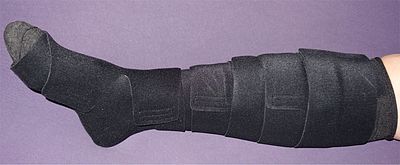Adaptive compression bandage
As part of the compression therapy come adaptive compression bandages , and Adaptive compression systems , used to decongest the legs and edema to reduce. Since these bandages are fixed to the leg with Velcro , it is possible to adjust the compression pressure, i.e. to adapt (from the Latin verb 'adaptare', to adapt , to change ).
These products are also known as wrap bandages, Velcro bandages or adaptive compression systems.
Mode of action
The reduction in the size of the veins by compression therapy has two effects. On the one hand, damaged venous valves can perform their valve function again, on the other hand, the blood flow is accelerated. These effects are already present when the leg is at rest, but are increased considerably when the muscle pumps in the ankle and calf are activated during movement. Such pressure is usually achieved by bandages in compression therapy. Here come binding, binding systems or adaptive compression bandages for use.
construction
The different models of adaptive compression supports can be constructed differently. Basically, it is a little stretchable bandage that surrounds the lower leg and adheres to itself with Velcro. This bandage is machine washable and can be reused. A protective liner or a so-called tubular bandage can be put on underneath the bandage. An additional ankle-length compression stocking or a correspondingly smaller bandage can be used to apply the compression pressure on the foot. With some models, the Velcro fasteners allow the patient to readjust the compression pressure independently. This can be appropriate if the person concerned cannot tolerate the existing compression pressure or if the leg circumference has decreased due to the reduction in edema .
application
Adaptive compression bandages are used at the beginning of compression therapy in the decongestion phase (also the initial decongestion phase ). They are used to care for patients with leg edema and venous leg ulcers , the so-called "open leg", and can also be used for existing underlying or concomitant diseases such as diabetes mellitus , polyneuropathy and peripheral arterial occlusive disease (PAOD) .
Depending on the model, the bandage is cut to size before it is applied. The compression pressure is adjusted segmentally by closing the Velcro fasteners from the ankle to the knee. In some models, the pressure generated can be defined using a template and using markings on the drum. When the decongestion of the leg has been completed - usually after three to four weeks - compression therapy with compression stockings is continued.
literature
- Kerstin Protz, Joachim Dissemond, Knut Kröger: Compression therapy An overview for the practice. Springer Verlag, Berlin a. a. 2016, ISBN 978-3-662-49743-2
Individual evidence
- ^ A. Williams: A review of the evidence for adjustable compression wrap devices , Journal of Wound Care, Volume 25, Issue 5, May 2016, page 242 - page 247
- ↑ J. Dissemond et al .: Compression therapy of ulcus cruris in Der Dermatologist CME-online 2016, doi : 10.1007 / s00105-016-3765-7
- ↑ G. Mosti et al .: Adjustable Velcro Compression Devices are More Effective than Inelastic Bandages in Reducing Venous Edema in the Initial Treatment Phase: A Randomized Controlled Trial in European Journal of Vascular and Endovascular Surgery, 50 2015, page 368 - page 374, doi : 10.1016 / j.ejvs.2015.05.015
- ↑ J. Dissemond, M. Moelleken, F. pure Boldt-Jockenhöfer, C. Erfurt Mountains: "compression therapy with medical adaptive compression systems: results of a retrospective analysis of 48 patients with chronic leg ulcers and edema ", in Wound Management 2020; Volume 14, No. 4, pages 177–181


